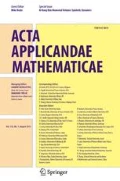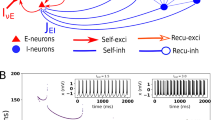Abstract
We introduce and study a new model of interacting neural networks, incorporating the spatial dimension (e.g. position of neurons across the cortex) and some learning processes. The dynamic of each neural network is described via the elapsed time model, that is, the neurons are described by the elapsed time since their last discharge and the chosen learning processes are essentially inspired from the Hebbian rule. We then obtain a system of integro-differential equations, from which we analyze the convergence to stationary states by the means of entropy method and Doeblin’s theory in the case of weak interconnections. We also consider the situation where neural activity is faster than the learning process and give conditions where one can approximate the dynamics by a solution with a similar profile of a steady state. For stronger interconnections, we present some numerical simulations to observe how the parameters of the system can give different behaviors and pattern formations.













Similar content being viewed by others
References
Abbassian, A., Fotouhi, M., Heidari, M.: Neural fields with fast learning dynamic kernel. Biol. Cybern. 106(1), 15–26 (2012)
Amari, S.i.: Dynamics of pattern formation in lateral-inhibition type neural fields. Biol. Cybern. 27(2), 77–87 (1977)
Cáceres, M.J., Carrillo, J.A., Perthame, B.: Analysis of nonlinear noisy integrate & fire neuron models: blow-up and steady states. J. Math. Neurosci. 1(1), 7 (2011)
Cañizo, J.A., Yoldaş, H.: Asymptotic behaviour of neuron population models structured by elapsed-time. Nonlinearity 32(2), 464 (2019)
Carrillo, J.A., Perthame, B., Salort, D., Smets, D.: Qualitative properties of solutions for the noisy integrate and fire model in computational neuroscience. Nonlinearity 28(9), 3365 (2015)
Chevallier, J., Cáceres, M.J., Doumic, M., Reynaud-Bouret, P.: Microscopic approach of a time elapsed neural model. Math. Models Methods Appl. Sci. 25(14), 2669–2719 (2015)
Crevat, J.: Diffusive limit of a spatially-extended kinetic FitzHugh-Nagumo model (2019). ArXiv preprint, arXiv:1906.08073
Crevat, J.: Mean-field limit of a spatially-extended FitzHugh-Nagumo neural network. Kinet. Relat. Models 12(6), 1329–1358 (2019)
Crevat, J., Faye, G., Filbet, F.: Rigorous derivation of the nonlocal reaction-diffusion FitzHugh–Nagumo system. SIAM J. Math. Anal. 51(1), 346–373 (2019)
Faye, G.: Existence and stability of traveling pulses in a neural field equation with synaptic depression. SIAM J. Appl. Dyn. Syst. 12(4), 2032–2067 (2013)
Faye, G., Faugeras, O.: Some theoretical and numerical results for delayed neural field equations. Phys. D: Nonlinear Phenom. 239(9), 561–578 (2010)
Faye, G., Rankin, J., Chossat, P.: Localized states in an unbounded neural field equation with smooth firing rate function: a multi-parameter analysis. J. Math. Biol. 66(6), 1303–1338 (2013)
Gerstner, W., Kistler, W.M.: Spiking Neuron Models: Single Neurons, Populations, Plasticity. Cambridge University Press, Cambridge (2002)
Hebb, D.: The Organization of Behavior: A Neuropsychological Approach (1949)
Kang, M.J., Perthame, B., Salort, D.: Dynamics of time elapsed inhomogeneous neuron network model. C. R. Math. 353(12), 1111–1115 (2015)
Ly, C., Tranchina, D.: Spike train statistics and dynamics with synaptic input from any renewal process: a population density approach. Neural Comput. 21(2), 360–396 (2009)
Michel, P., Mischler, S., Perthame, B.: General relative entropy inequality: an illustration on growth models. J. Math. Pures Appl. 84(9), 1235–1260 (2005)
Mischler, S., Weng, Q.: Relaxation in time elapsed neuron network models in the weak connectivity regime. Acta Appl. Math. 157(1), 45–74 (2018)
Pakdaman, K., Perthame, B., Salort, D.: Dynamics of a structured neuron population. Nonlinearity 23(1), 55–75 (2010). https://doi.org/10.1088/0951-7715/23/1/003
Pakdaman, K., Perthame, B., Salort, D.: Relaxation and self-sustained foscillations in the time elapsed neuron network model. SIAM J. Appl. Math. 73(3), 1260–1279 (2013). https://doi.org/10.1137/110847962
Pakdaman, K., Perthame, B., Salort, D.: Adaptation and fatigue model for neuron networks and large time asymptotics in a nonlinear fragmentation equation. J. Math. Neurosci. 4, 14 (2014). https://doi.org/10.1186/2190-8567-4-14
Perthame, B.: Transport Equations in Biology. Springer, Berlin (2006)
Perthame, B., Salort, D., Wainrib, G.: Distributed synaptic weights in a lif neural network and learning rules. Phys. D: Nonlinear Phenom. 353, 20–30 (2017)
Pham, J., Pakdaman, K., Champagnat, J., Vibert, J.F.: Activity in sparsely connected excitatory neural networks: effect of connectivity. Neural Netw. 11(3), 415–434 (1998)
Wilson, H.R., Cowan, J.D.: Excitatory and inhibitory interactions in localized populations of model neurons. Biophys. J. 12(1), 1–24 (1972)
Funding
This project has received funding from the European Union’s Horizon 2020 research and innovation programme under the Marie Skłodowska-Curie grant agreement Number 754362.
Author information
Authors and Affiliations
Corresponding author
Ethics declarations
Conflict of interest
Not applicable.
Availability of data and material
Graphics of simulations were generated by the Matlab software.
Additional information
Publisher’s Note
Springer Nature remains neutral with regard to jurisdictional claims in published maps and institutional affiliations.
Rights and permissions
About this article
Cite this article
Torres, N., Salort, D. Dynamics of Neural Networks with Elapsed Time Model and Learning Processes. Acta Appl Math 170, 1065–1099 (2020). https://doi.org/10.1007/s10440-020-00367-1
Received:
Accepted:
Published:
Issue Date:
DOI: https://doi.org/10.1007/s10440-020-00367-1




